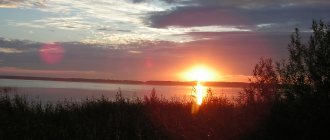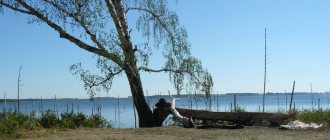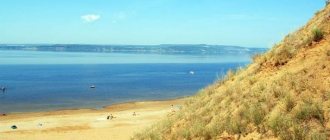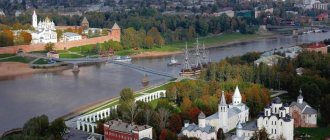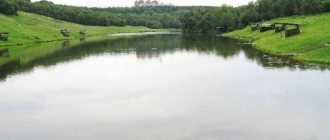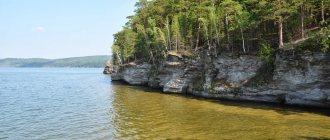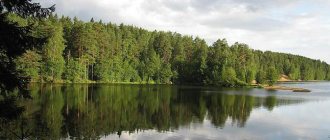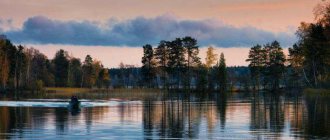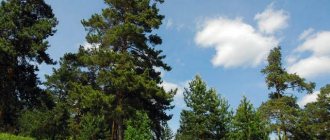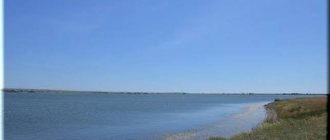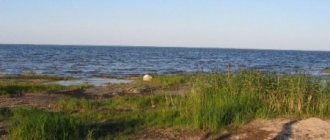Chebak, Perch, Pike, Soroga, Bream and White Bream
Lake Itkul is located in the north of the Chelyabinsk region, not far from the border with the Sverdlovsk region. This is probably the most beautiful and clean (water transparency reaches 4 meters) lake in the southern Urals. It is worth noting that Itkul received the official status of a natural monument and reserve. Its size is approximately 8 kilometers in length and 6 in width. The maximum depth is no more than fifteen meters. The bottom is mostly sandy and rocky, so the lake has little food for fish.
The eastern coast is steep, although there are small sandy beaches, the western coast can be described as flat and wooded, it is more similar to the shores of the lakes of the Middle Urals. In the water, near the southern edge of the lake, stands the famous “Shaitan Stone”, and in the rocks near it there are several small caves. But besides it, there are many beautiful rocks and outcrops along the southeastern coast. The landscapes on the gentler banks are also very picturesque.
On the northern shore is the village of Dautovo and on the northeastern shore is the village of Itkul, so they are less interesting for fishing and recreation. On the eastern shore of the lake there is a source blocked by an adjustable sluice. It flows into Lake Sinara, located in a closed area of the city of Snezhinsk. Therefore, apparently, fishing in this small river is often more interesting than on Itkul itself.
These fertile places were inhabited for a very long time. According to archaeological excavations, about 7,000 years ago. And about 2,700 years ago, the so-called Itkul culture with extremely developed metallurgy arose and existed for about 400 years.
At the site of the ancient settlements, archaeologists found many metallurgical furnaces, ore, crucibles and foundry molds. The Turkic name of the lake - Itkul - consists of two words: it - “meat”, kul - “lake”, and, apparently, indicates that the lake is rich in fish.
The village of Itkul is older than Yekaterinburg and Chelyabinsk, it is more than 300 years old. It is interesting that during the founding of Yekaterinburg, the Bashkirs who lived near the future city were deported by Tatishchev and de Genin precisely to the shores of this lake. So, in a way, the local population is the descendants of our failed fellow countrymen. But they hardly have any reason to be offended. If we compare the climate and nature of the capital of the Urals and these places, it should be noted that, despite the distance of only 100 kilometers, it is always much sunnier and warmer in this area.
Often, leaving Yekaterinburg in the rain, you arrive there on a warm summer day, and on the way, gloomy spruce forests and swamps right before your eyes turn into meadows with sun-lit birch groves on the hills. However, the natives have a very unique attitude towards the surrounding nature. We were unpleasantly surprised to discover that the smoky quartz boulders, which lay in rows on the beach and decorated this shore for centuries, were simply stolen to decorate summer cottages. When washed, the boulders are extremely beautiful. Now this beach is bare and boring.
The road from Yekaterinburg, if you drive slowly, will take you about an hour and a half. Through Gorny Shchit, Polevskoy, the village of Poldnevaya, that is, moving straight along the P-355 highway all the time, fifteen minutes after crossing the border of the regions, which you will feel by the sharp deterioration in the quality of the road surface, you will find yourself in the village of Dautovo on the shore of the lake. The road goes further along the eastern shore, but there is a dirt road around the circumference of the lake, so you are not limited in choosing a place.
About the lake
Itkul is a lake located in the north of the Chelyabinsk region, 20 kilometers from the city of Verkhny Ufaley. Lake Itkul is one of the beautiful places in the Chelyabinsk region. Declared a natural monument.Etymology
Pavel Petrovich Bazhov wrote in “Demidov’s Caftans”:
“And Itkul-Lake was in a high place. The shores are sand and stone, dry and dry, and all around there are fire pine trees. How the candles are placed. Lovely to watch. The water is like glass - count all the stones at the bottom. Just a little red. How exactly they rinsed the meat in it. The bottom, you see, is sand-butcher, it flows towards it like that. That’s why Lake Itkulem is called. In Bashkir, the name for beef is it, and in theirs, kul is a lake, so the meat lake came out - Itkul.”
According to another version, the name used to sound like “Ikkul”; to be more precise, “Yyykkul”, which means “sacred lake”.
The most likely origin of the name, close to the truth, is from the Turkic personal male name Itkol (Etkol), previously widespread among the Bashkirs. This could be the name of the patrimonial owner, clan group.
Geography
The lake is surrounded by low mountains, the highest of them is Karabaika (544 m) on the southwestern shore of Lake Itkul. Here the small river Karabaika flows into Lake Itkul. The name goes back to the Tatar-Bashkir karabay, literally “black bai (rich man).”
The villages of Dautovo and Itkul are located on the banks. The age of the village of Itkul is more than 300 years. In the village of Dautova (Dautovo) there is a monument to the Bashkirs-Tersyaks who participated in the War of 1812.
On the lake there is an original “pebble” island, consisting of a pile of stones and boulders. From a distance it looks like a herd of cows climbing into the water from the heat.
Shaitan-stone
The southern shore of the lake is mostly steep; in some places the cliffs are very high. Opposite one such cliff in the water there is a lonely rock called “Shaitan-stone” (Arabic shaitan - “evil spirit”, “devil”). Shaitan stone played an important role in people's lives. There was a custom[3]: if the summer is rainy and the sky is overcast, you need to slaughter a white ram on Shaitan Stone - and the sun will open. If there is a drought and you need to ask God for rain, you should slaughter a black sheep there.
In the tale “Golden Hair” P. P. Bazhov tells another local legend:
Dedko Filin then says:
- I’ll tell you a reliable note. Run around, look around the lakes and you will see - in one of the middle there is a stone standing poking like a hill. On one side there are pine trees, and on three - bare, like the walls are lined. This is the place. Whoever gets to this stone with gold will have a passage open downwards, under the lake. You can't take Poloz here.
In 1973-1976. A pumping station was built on the western shore of the lake to transfer lake water to Chusovaya. After pumping out 2.5 meters, a “cave” opened under the Shaitan Stone.
Story
Bashkirs have lived on the lake for more than three centuries. In general, people fell in love with this lake 7,000 years ago. Archaeologists have never left the shores of the lake without a “catch.” And they even made a discovery here. It turns out there was such a people - the Itkul people. Researchers N.B. Vinogradov and others assign them 400 years of history. 2700 years ago they “emerged” and disappeared four centuries later. The Itkul people were metallurgists and blacksmiths. Their time dates back to the early Iron Age, but they remained specialists in copper and bronze. At the site of their ancient settlements, archaeologists found up to three dozen metallurgical furnaces at once, in one place, as well as slag, ore, crucibles, and foundry molds. Having discovered a striking similarity between the bronze weapons that the Itkul people forged and the weapons of the steppe nomads of the southern regions of the Urals, as well as the abundance of horses in the Itkul herds, which is unusual for forest people, archaeologists assumed a market, barter exchange between northerners and southerners.
What to catch on Lake Itkul.
Fishing here is very varied. The lake offers good fishing for roach, perch, bream, pike and pike. Ichthyologists use this reservoir to maintain the breeding stock of whitefish. So you also have a chance to catch peled or dace. There are tench and crucian carp. There are a lot of small fish in the lake, and at the very beginning of summer, many places, especially on the western shore, turn into continuous spawning grounds. Each stone lifted from the water resembles a sandwich with caviar. The highlight of fishing on this lake is, undoubtedly, catching sorog. But we’ll talk about it in the next article, but for now we’ll talk about catching more common fish.
Legends of the lake
Itkul (lake, Chelyabinsk region) has an ancient legend associated with its name. In ancient times, the Master of the Water lived on a reservoir, who did not like it when people caught fish in his lands. He often swam to the surface and dragged unwary fishermen into the deep pool. People tried to appease the spirit with gifts, but it did not work.
Then the local residents called upon the hero Itu to protect them. He threw a net into the lake, which angered the Master of the water. They agreed to fight three times to determine the winner. The hero decided to cheat and called his younger brother, the bear, for help. He struggled with his spirit for a long time, but the forces were equal, the opponents were marking time. As a result, a swamp formed there.
Then the hero invited the Master of the water to fight the tiger, his older brother. For this service, the beast asked the young man for permission to catch plenty of fish in the lake at any time. As soon as the Spirit appeared above the water, the tiger grabbed him. They fought for a long time, but the beast did not let go of his opponent.
The owner of the water admitted defeat and, hating the whole wide world, crawled under a heavy stone. Since then, everyone can calmly fish in the reservoir, and the lake was named Itkul in honor of the hero.
There is also a legend associated with the Shaitan stone sticking out of the water. There were two spirits - Evil and Good. They were brothers, but they walked the world separately. Dobro gave gifts to people, gave the best. Evil was hard and cold, like a rock, and always hit people in the most vulnerable place.
One day the brothers met and a dispute began about who was doing the right thing and who was going the wrong way, but they never found the truth. Then Good decided to show that the heavenly law is like a surface of water reflecting the sky, and turned into a beautiful lake. Evil responded by becoming a black gloomy rock in the pond, which immediately caught the eye.
Since then, people called the lake Sacred and asked it for the desired gifts. The huge dark stone became Shaitan. People turned to him to learn how to defeat their enemies. And the brothers are still arguing, remaining in their new images.
Catching Chebak on Lake Itkul.
You can successfully catch chebak from any shore of the lake;
chebak are of different sizes (up to 200 grams) and bite best on raspberries. But, according to our observations, there is more of it on the eastern shore. In addition, in late spring, when the lake is overflowing with melt water, the source sluice in Sinara opens and a large number of fish go up from there to spawn and, naturally, run into the sluice. For about two weeks, near the sluice of the river (six meters wide and about a meter deep), the bite was beyond praise. Sometimes we caught a bucket of chebak and medium-sized sorog within two hours. You have to fish with a wire in a seething stream and with a very sensitive float, since the bites are very weak in still icy water. Fishing is done more “on intuition” and is very exciting. True, on weekends there are sometimes too many fishermen there.
Fishing for Perch and Pike on Itkul
The perch off the eastern shore is small. Exceptions are extremely rare. It is better to catch large perch and pike using a spinning rod from the western and southern shores of the lake. Perch prefers small spinners and always stands closer to the bottom. There was no preference in color, but we usually enclosed the spinners additionally to make it easier to guide at depth. But there are exceptions. One day we caught a large school of perch off the eastern shore, hiding under the meter-long pipes of an old water intake that went under the water. Local fishermen said that perch come there periodically.
Pike comes as by-catch for perch - it looks like there isn't much of it there. Vibrating tails of natural colors measuring about 7 centimeters work well on it. Perhaps the transparency of the water has an effect; the presence of color highlights visible from afar, scattered, for example, by an oscillating spoon, rather scares away the fish.
It is more effective to catch pike from a boat, near the reed islands scattered along the gently sloping shores. Perch also bites there, but more actively with a fishing rod than with a spinning rod. The bait he prefers is a worm.
Flora and fauna of Lake Itkul
As we have already said, the reservoir is rich in fish. Previously, the Arakul fish factory carried out commercial fishing for bream (50 tons per year). Nowadays, fishermen can please themselves with burbot, whitefish, ripus, pike, perch, etc. You can collect crayfish under the stones near the shore.
In the protected zone you can meet birds listed in the Red Book: swan, white-tailed eagle, European black-throated loon and great river eagle.
A rare plant that grows on the banks of Itkul is feather feather grass.
Fishing for Bream and Podleschik on Lake Itkul
Bream and bream on Itkul are reluctant to go to the shore. You have to catch it from a boat. He likes to stand in holes located either in the center of the lake or closer to the northern shore. The bottom topography there is extremely uneven and it is advisable to have an echo sounder. The bream's bite at the height of summer often continues until sunset. In terms of bait preferences, it is no different from other lakes in the Urals: raspberries, bread, worms, maggots. We did not try feeding: it hardly makes sense when fishing in a pit.
And finally, a few everyday details. There are shops in the villages on the shore, but their range is extremely poor. It's better to take everything with you. But you don’t have to worry about firewood. They are sold near many houses facing the road in both villages. It’s better to start setting up the camp in advance, since the lake is located in a relatively flat basin and at sunset it gets dark there very quickly.
We recommend reading:
Taimen is a shark from the river. How to catch taimen?
How to catch crayfish, where to look for them and when.
Fishing on the Ingoda river. Lenok and grayling in winter.
Fishing on Podkamennaya Tunguska. What to fish with.
Lake Itkul
Lake Itkul is a natural monument.
Lake Itkul is located in the north of the Chelyabinsk region and is a natural monument. Its length is 8 kilometers, width 6 kilometers. Maximum depth 16 meters, average 8. Water transparency 4 meters. The water is fresh. The bottom is muddy, sandy, and uneven. There are few reed thickets, but underwater vegetation (especially elodea) is abundant. The lake is surrounded by wooded hills, and in some places there are rocky headlands near the water. The eastern shore is rocky and steep. The western bank is flat. The famous “Shaitan Stone” protrudes on the southern shore. 8 small rivers flow into the lake. The only source, the Istok River, flows into Lake Sinara. There are quite a few recreation centers on the western shore of the lake. In the northwest is the village of Saima, in the north is the village of Dautovo, in the northeast is the village of Itkul.
Roach, perch, bream, pike, dace, ide, tench, ruffe, yellow crucian carp, burbot, bleak. The reservoir is used for the reproduction of whitefish: the breeding stock of these fish species lives in it. Every year, ichthyologists collect several tens of millions of eggs. There are a lot of small crayfish on the lake.
District: Verkhniy Ufaley Distance from Chelyabinsk - 170 kilometers. We leave along the Sverdlovsk tract, then Dolgoderevenskoye - Argayash - Kuznetskoye - Kyshtym - Kasli - Verkhniy Ufaley. Before Verkhniy Ufaley we turn to Lake Itkul, to the right. Next we drive through the village of Selki to Lake Itkul. From Yekaterinburg through the village of Poldnevaya and further to the southeast. There are a lot of approaches to the lake, but they are dug up periodically.
Source
How to get to Lake Itkul
From Chelyabinsk and Yekaterinburg you can get to the reservoir in different ways.
By car
From Chelyabinsk you need to follow the M-36 highway towards Yekaterinburg until the turn to Argayash, then take the direction to Kyshtym - Snezhinsk - Itkul. You can take M-36 to the sign “Snezhinsk” and turn left. After Snezhinsk, choose the path to Itkul. The first route is 170 km, the second - 165 km.
From Yekaterinburg you need to choose the direction Kurganovo - Polevskoy - Itkul. Or, following the M-36 highway, get to the turn to Snezhinsk, then turn right and continue along the road to Lake Itkul. The first route is 107 km, the second is 145 km.
By public transport
Electric trains, trains and buses run from Chelyabinsk and Yekaterinburg to Verkhniy Ufaley. To cover the further path to the lake (20 km), it will be easier to use the services of private carriers. The schedules can be found on the website.
- "Chelyabinsk - Verkhny Ufaley".
- "Ekaterinburg - Verkhniy Ufaley".
When traveling by regular buses, you must get off at the turn towards Lake Itkul. Stopping is available upon request.
Lake Itkul and Shaitan-stone: video
Itkul: recreation, fishing and legends
This lake is one of the ten most popular lakes among tourists in the Chelyabinsk region.
20 kilometers - distance from the city of Verkhny Ufaley.
Hydrological natural monument.
30.1 square kilometers is the water area.
154 sq. kilometer is the catchment area.
274.7 meters above sea level - the height of the water's edge.
Several rivers flow into the lake (Karabaika, Dolgaya, Burkalka, Zyuzelga and others), only the Itkulsky Istok stream flows out. After 11 kilometers it flows into Lake Sinara.
On Itkul you can admire the “amphitheater” of low but picturesque hills: Karabayka, Vishneva, Konskaya, Dolgorechenskaya, Tugashinskaya and others.
544 meters above sea level - the height of the dominant peak in the area, Mount Karabayki. The river of the same name flows into the lake right there. “Karabay” translated from Turkic means “black rich man”.
On the shore of the lake there are two villages - Dautovo and Itkul. The age of the last of them is more than 300 years.
Features of the lake
Itkul has an oval shape. From north to south the lake extends for 7 kilometers, from west to east – up to 5 kilometers. Water area 30.1 sq. km, volume 234.8 million cubic meters. The catchment area is 154 sq. km. The water's edge is located at 274.7 meters above sea level.
The lake has considerable depth. The average depth is 7.8 meters, the maximum is 16.6 meters. The water is clean and transparent (the bottom is visible to a depth of 4-5 meters). Water mineralization 167 mg/l. It belongs to the calcium hydrocarbonate type and has significant alkalinity. In summer, the lake takes a long time to warm up.
The reservoir is surrounded by pine and birch forests. Many rivers flow into the lake, the most notable of which are: Dolgaya, Karabaika, Burkalka, Zyuzelga. The Itkulsky Istok stream flows out of the lake, which after 11 km flows into Lake Sinara. At the outlet of the river from the lake, a dam was built to regulate the flow.
Near the gateway, notice the ancient bicentennial sedge poplars, three girths thick, growing on both sides of the road. According to legend, they were imprisoned by order of Akinfiy Demidov (which is doubtful). One way or another, the poplars are really very old, planted to strengthen the dam (the locals call this place the Dam). Previously, 40 poplars grew here. Now the old poplars are dying and falling.
Itkul is surrounded by low but picturesque hills. Among them: Karabayka, Vishnevaya, Koskaya, Dolgorechenskaya, Tugashinskaya and others. The highest peak is Mount Karabayka (544 meters). Previously, every spring, the Bashkirs sacrificed a white horse on the stones at the top of Mount Karabayka. They believed that after this the horses would be fat and no pestilence would take them. From the top there is a magnificent view of the lake.
Along the shores of the lake there are very beautiful, multi-colored pebbles. You can also find garnet crystals in the sand. Sands with a high garnet content, up to 1 m thick, stretch along the coast for 9 km. Garnet shales are exposed along the shore. And on the northwestern shore of Lake Itkul there is a known deposit of amethysts. It was accidentally discovered by a peasant who discovered a large nest of amethysts under a layer of soil. They were taken out of here by cartloads. As mining engineer Nikolaev noted in 1912, local amethysts were cut with rutile needles.
The lake is rich in fish (there is a reason for its name). Here you can find: roach, bleak, perch, ruffe, crucian carp, bream, pike, dace, ide, tench, crucian carp, burbot, whitefish, ripus. In the past, commercial bream fishing was carried out here, reaching 500 centners per year. The lake was used by the Arakul fish factory. There are also crayfish here.
On the lake and in the protected zone there are rare species of animals listed in the Red Book of the Chelyabinsk region: white-tailed eagle, European black-throated loon, swan, beauty damsel, brilliant beauty, great sparrow, brown forest ant. Among the rare plants, feather feather grass is noted.
The lake is a hydrological natural monument of the Chelyabinsk region. This status was assigned in 1987. The Shaitan-stone rock also has a protected status. Since 1985, the geological section of the Proterozoic on Lake Itkul was considered a separate natural monument, but in 2008 it was abolished.
In summer there are always a lot of vacationers on the banks of Itkul, but you can find a place for a tent.
Shaitan-stone
Located in the northwestern part of the lake.
20 meters is the distance from the shore.
"Shaitan" translated from Arabic means "devil, evil spirit."
Mentioned in the tale of P.P. Bazhov "Golden Hair".
According to legend, the habitat of Snake.
After the water level decreased due to pumping in the 1970s, a cave opened on Shaitan Stone.
Lake Itkul - the beauty of the Chelyabinsk region
In the Bazhov tale “Demidov’s kaftans” the name Itkul is translated from Bashkir as “meat lake”, that is, “nourishing”, full of fish. But there are other versions.
Initially the lake was called Ikkul or Yyykkul, which means “sacred lake”. And besides, the name of the reservoir may come from the male Bashkir name Etkol or Itkol. Perhaps this was the name of the owner of the fiefdom or the head of the clan group.
Lake Itkul is oval in shape.
Seven kilometers is its length from north to south.
Five kilometers - from west to east.
7.8 meters is the average depth.
16.6 meters - maximum.
167 grams per liter - water mineralization.
Depth of Lake Itkul in Chelyabinsk
Lake Itkul in winter Direction from Yekaterinburg: Polevskoy Distance from Yekaterinburg (range): 50-100 km How to get there:
Distance from Yekaterinburg – 90 km.
We drive along the road Polevskaya - Verkhniy Ufaley - Poldnevaya and further to the southeast. There are many approaches to the lake, but they are dug up periodically.
Distance from Chelyabinsk – 140 km.
From Chelyabinsk we drive along the road to Yekaterinburg, turn onto Argayash near the village of Dolgoderevenskoye, then go to Kuznetskoye, then to Kyshtym - Kasli - Verkhniy Ufaley. Before Verkhniy Ufaley we turn right towards Itkul. We drive through Selki to the lake.
Average depth: 2m Maximum depth: 10m Maximum length and width (km): 8*6.km Water transparency, cleanliness: 4 meters. Sources of water supply: 8 small rivers: Dolgaya, Karabaika, Burkalka, Zyuzelga and others. Flowing rivers: the Istok River, flowing into Lake Sinara. Height above sea level: 273m Area: 30.4 km 2 Wild recreation:
In tents, in a car, on wild beaches on the north coast.
There are several recreation centers and camp sites on the shore. There are several paid beaches on the northern shore, the cost is from 300 to 600 rubles per car. The best equipped beach is near the village of Itkul, there are football and basketball fields, toilets, a good road, and weekly beach cleaning. There is only one drawback - the beach is located on the way to the watering place of the local cows.
Available services: accommodation, boat rental, beaches, recreation, sports fields, toilets. Fee: Free Bottom: silt, sand, pebbles. Fish:
The lake is rich in fish and small crayfish. Used for the reproduction of whitefishes, ichthyologists collect several tens of millions of eggs every year.
On the southwestern shore is the famous Shaitan Stone. Lake Itkul is a hydrological natural monument. The name of the lake, translated from Bashkir, means either “meat lake” (rich in fish), or, according to another version, the name used to sound like “Yyykkul” - “sacred lake”. But the most likely origin of the name is from the Turkic personal male name Itkol (Etkol), which was previously common among the Bashkirs.
Winter fishing on Itkul
Fishing on Lake Itkul
Geographic coordinates: longitude: 60°32′3.67″E (60.534354), latitude: 56°8′55.37″N (56.148715). Settlements on the coast: Selki, Dautovo, Klyuchi, Verkhniy Ufaley 20 km. Peculiarities:
Lake Itkul is located in the northwestern part of the Kasli region. There are few reed thickets, but underwater vegetation, mainly elodea, is very abundant. Surrounded by wooded hills, there are sometimes headlands near the water. Nearest lakes: Tatysh, Tashkul, Semikul.
Source
